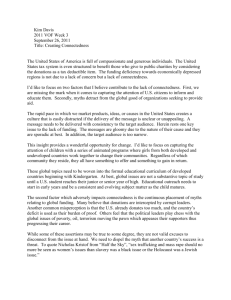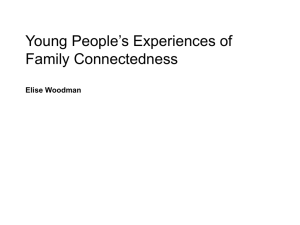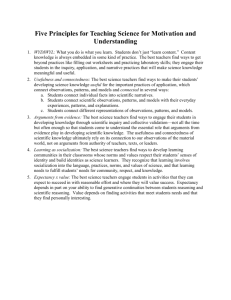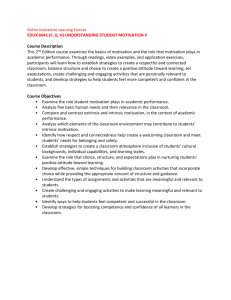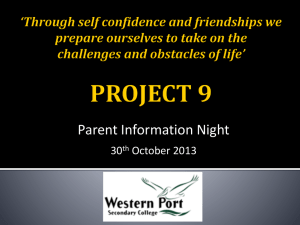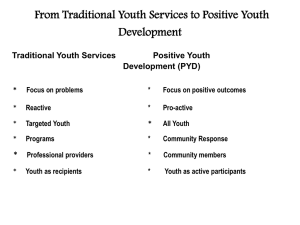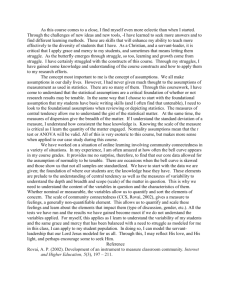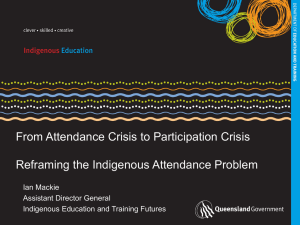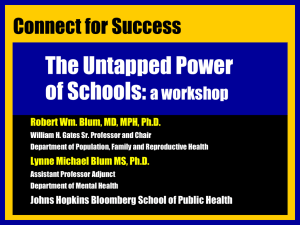School Connectedness - Center for Effective Collaboration and
advertisement
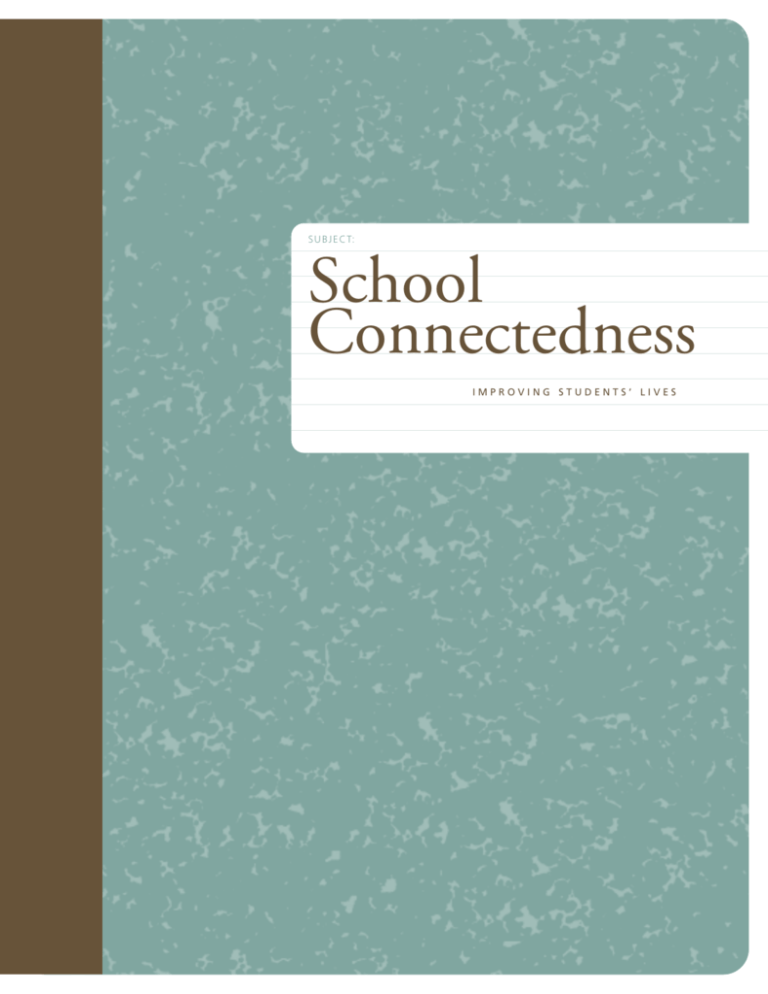
S U B J E C T: School Connectedness IMPROVING STUDENTS’ LIVES Introduction The report that follows has been supported by a grant from the U.S. Department of Defense. While it draws on research and examples from public schools across America, the issues of school connectedness have special salience for children who have one or both parents in the armed services. Today there are well over a million military kids in U.S. public schools, and over the next few years, those numbers will increase. Table of Contents SECTION 1 The Value of Connections . . . . . . . . . . . . . . . .1 The Case for School Connectedness School As a Critical Developmental Venue SECTION 2 Individuals Create School Connectedness . . . . .4 Promoting Positive Outcomes The Importance of Teachers Evidence-based Strategies to Enhance Connectedness SECTION 3 School Environments Affect Connectedness . . .9 What Makes a School Engaging? School Leaders Can Improve the Climate Best Practices for Improving Parent-School Relations Research has taught us that second only to family, school is the most important stabilizing force in the lives of young people. For military children, who may move as many as 15 times before they graduate from high school, a school environment where they feel secure and ready to learn is critical. Because they often feel like “the new kid on the block,” having someone to sit with at lunch, a teacher who helps them catch up with class assignments, a coach who finds a way to incorporate them into a team—even after the season begins—is vital to their success. America is a country on the move. Today, many children relocate frequently. Though few will move with the frequency of military children, the extent to which schools create stable, caring, engaging and welcoming environments is the extent to which all our kids will thrive. SECTION 4 School Culture and Connectedness . . . . . . . .12 Enhancing Connectedness Through Health Promotion SECTION 5 Strategies Warranting Further Research . . . . .15 SECTION 6 References and Additional Readings . . . . . . . .16 References ACKNOWLEDGEMENTS Author: Robert Blum MD, MPH, PhD Dr. Blum is the William H. Gates Sr. Professor and Chair, Department of Population and Family Health Sciences, Johns Hopkins Bloomberg School of Public Health. This document is a product of the Military Child Initiative and was developed through support provided by the Department of Defense Military Child in Transition and Deployment State Liason Office. It draws upon the commissioned papers and concluding declaration on School Connectedness generated at an invitational conference held at the Wingspread Conference Center in June 2003 and published in the Journal of School Health, September 2004. That conference was sponsored by the Centers for Disease Control and Prevention, Division of Adolescent and School Health. The Value of Connections School connection is the belief by students that adults in the school care about their learning and about them as individuals. Students are more likely to succeed when they feel connected to school. Critical requirements for feeling connected include high academic rigor and expectations coupled with support for learning, positive adult-student relationships, and physical and emotional safety. Increasing the number of students connected to school is likely to improve critical accountability measures. Strong scientific evidence demonstrates that increased student connection to school decreases absenteeism, fighting, bullying and vandalism while promoting educational motivation, classroom engagement, academic performance, school attendance and completion rates. AMERICAN TEENS CAN H AV E S T R O N G E R H E A LT H A N D E D U C AT I O N A L OUTCOMES. INCREASING SCHOOL CONNECTEDNESS CAN MAKE THAT HAPPEN. Research has shown that students who feel connected to school do better academically and also are less likely to be involved in risky THE CASE FOR SCHOOL CONNECTEDNESS health behaviors: drug use, In order to succeed, students need to feel they “belong” in their school. People call that sense of belonging many things. Some researchers study “school engagement” while others study “school attachment,” and still others analyze “school bonding.” To complicate matters even more, research on students’ attachment to the schools they attend is conducted in a variety of disciplines: education, health, psychology and sociology. Are all these people talking about the same thing? cigarette smoking, early sex, violence and suicidal thoughts and attempts. This report summarizes what is known about school connectedness. By and large, the answer is yes. While each discipline may organize data and terms differently, conduct analyses in different ways, and even use different descriptive words, consistent themes emerge. These seven qualities seem to influence students’ positive attachment to school: • • • • • • • Having a sense of belonging and being part of a school Liking school Perceiving that teachers are supportive and caring Having good friends within school Being engaged in their own current and future academic progress Believing that discipline is fair and effective Participating in extracurricular activities These factors, measured in different ways, are highly predictive of success in school. Because each of these seven factors brings with it a sense of connection —to oneself, one’s community or one’s friends—it is clear that school connectedness makes a difference in the lives of American youth. SCHOOL CONNECTEDNESS — T h e Va l u e o f C o n n e c t i o n s PAGE 1 S C H O O L A S A C R I T I C A L D E V E L O P M E N TA L V E N U E In the healthy development of children and youth, grades, participation, a sense of belonging, and relationships with students and teachers are important in feeling connected to school—and connected students do better. There are those who believe that schools should focus only on the acquisition of knowledge or that we expect too much from schools. However, current research across disciplines shows that non-academic aspects of school are also significant contributors to both school and student success. HIGH SCHOOLS T H AT W O R K Based on current research evidence, students’ school connectedness can be increased through the following strategies: The High Schools That Work model combines vocational and • college preparatory studies that include high expectations, work-based learning, teacher • • collaboration, guidance and ongoing student evaluation. • To participate, 1300 schools in • 21 states that currently use the High Schools That Work model • must commit to participating for While each has its own nuance, school connectedness is influenced through the interaction of three dynamic concepts and relationships, which we discuss in the following sections: five years. Extensive training, with on-site assistance, is • mandatory for the first three years. Schools showed significant Implement high standards and expectations, and provide academic support to all students. Apply fair and consistent disciplinary policies that are collectively agreed upon and fairly enforced. Create trusting relationships among students, teachers, staff, administrators and families. Hire and support capable teachers who are skilled in content, teaching techniques and classroom management to meet each learner’s needs. Foster high parent/family expectations for school performance and school completion. Ensure that every student feels close to at least one supportive adult at school. • • Individuals: Students and school staff Environment: School climate and school bonding Culture: Social needs and school learning priorities improvements in curriculum instructional practices and student performance indicators. PAGE 2 T h e Va l u e o f C o n n e c t i o n s — SCHOOL CONNECTEDNESS Individuals STUDENTS WHO PERCEIVE THEIR TEACHERS A N D S C H O O L A D M I N I S T R AT O R S A S C R E AT I N G A C A R I N G , WELL-STRUCTURED LEARNING ENVIRONMENT I N W H I C H E X P E C TAT I O N S A R E H I G H , C L E A R A N D FA I R A R E M O R E L I K E LY T O B E C O N N E C T E D T O S C H O O L . Individuals Create School Connectedness By the time they are in high school, as many as 40 to 60 percent of all students—urban, suburban and rural—are chronically disengaged from school. That disturbing number does not include the young people who have already dropped out. What is behind this serious disengagement, and what can be done about it? Relationships formed between students and school staff members are at the heart of school connectedness. First, we must recognize that people connect with people before they connect with institutions. The relationships formed between students and school staff members are at the heart of school connectedness. Students who perceive their teachers and school administrators as creating a caring, well-structured learning environment in which expectations are high, clear and fair are more likely to be connected to school. But it is not just teachers and administrators who create these important connections. Janitors, coaches, lunchroom servers, office assistants, counselors, parents and school volunteers—in short, all adults—are critically important in this dynamic. Simply put, when we create more personalized educational environments, students respond and do better. Teachers report and research confirms that connected students pay better attention, stay focused, are motivated to do more than required, and tend to have higher grades and test scores. PROMOTING POSITIVE OUTCOMES As any 21st century teacher will attest, schools can be either a positive or negative force in a student’s life. Sometimes, it’s a matter of young people connecting to less-than-desirable models. Parents have believed for decades that young people who build strong social connections to individuals who engage in risky behaviors are more likely to take the same risks. These parents are appropriately concerned—and they are right. School connectedness, however, has been shown to protect youth from engaging in risky behaviors. The health benefits of positive versus negative behaviors are obvious. Across all racial, ethnic and income groups, evidence is mounting that students who feel more connected to school are less likely to: • • • • • PAGE 4 Exhibit disruptive and violent behavior Carry or use a weapon Experiment with illegal substances Smoke cigarettes Drink to the point of getting drunk Individuals — SCHOOL CONNECTEDNESS • • • FIRST THINGS FIRST Appear emotionally distressed Consider or attempt suicide Engage in early-age sexual intercourse The First Things First model is employed district-wide in Kansas T H E I M P O R TA N C E O F T E A C H E R S Peer social acceptance alone does not protect students from risk. Children must be taught in ways that motivate, engage and involve them in learning. Critical to that is the relationship between the teacher and the student. Indeed, teacher support is essential in guiding students toward positive, productive behaviors. This relationship allows students to develop a stake in their own achievement. Effective teachers use proactive management strategies. They establish consistent classroom expectations and routines, and they recognize and reward desirable student behavior. They help students set both academic and behavioral goals, share the goals with parents, and review them periodically. City and has projects in rural and urban communities nationwide. Its goal is to build close, respectful and productive studentteacher relationships in poor communities through intensive, high-quality teaching. These small learning communities have Effective teachers use interactive and experiential teaching methods that are oriented to explicit learning objectives. They develop assignments in which students investigate issues, interview people, visit sites and report back to the teacher. They involve small teams of students of different ability levels and recognize the academic improvement of individual team members. high, fair and clear academic These teachers become a creative, energizing force in the learning process, and their importance cannot be overestimated. Many individuals credit their adult success to one caring, inspiring teacher they had as a youth. included in a family advocacy and behavioral expectations. Students, who are grouped together for two years, are program and participate in performance-based assessment E V I D E N C E - B A S E D S T R AT E G I E S T O E N H A N C E C O N N E C T E D N E S S aimed at relevance to their Looking across the extensive research from whole-school reform to parent and community involvement, a number of strategies recur. Educators and all those committed to the education of America’s youth can use these strategies to foster connectedness among young people and with the schools they attend. School is the business of youth, and administrators and teachers can do much to improve students’ sense of connectedness. lives. Funding is flexible and Students must also actively participate in their own education. They need opportunities to become involved in cross-age and peer-led tutoring activities, serve as peer counselors, experience collaborative learning that pairs stronger and weaker students, and participate in new-student orientation programs, buddy programs and welcome programs. parent involvement, and follows the needs of the students. Participating schools noted decreased suspensions and increased attendance, reading achievement. Likewise, parents and community members can contribute to the success of the school. They can serve as mentors, participate in or provide opportunities for community service, take advantage of parent training opportunities, develop ongoing relationships between the school and corporations or universities, and provide opportunities for and participate in service learning. SCHOOL CONNECTEDNESS — Individuals PAGE 5 Environment SCHOOLS HAVE A RESPONSIBILITY TO PROVIDE STUDENTS WITH A SAFE ENVIRONMENT IN WHICH TO DEVELOP A C A D E M I C A L L Y, E M O T I O N A L L Y A N D B E H A V I O R A L L Y, W H I L E AT T H E S A M E T I M E D E V E L O P I N G R E L AT I O N S H I P S W I T H O T H E R S . School Environments Affect Connectedness Students’ relationships with teachers, administrators and other students do not develop in a vacuum. Schools are responsible for providing students with a safe environment in which to develop academically, emotionally and behaviorally. One element of the school environment is the school “climate,” which, at its most positive, includes a strong emphasis on academic achievement, positive relationships among students and teachers, respect for all members of the school community, fair and consistent discipline policies, attention to safety issues, and family and community involvement. SOCIAL COMPETENCE PROGRAM FOR YOUNG A D U LT S Six units designed to enhance personal and interpersonal effectiveness and to prevent maladaptive behaviors make up the Social Competence Program School climate and connectedness are interrelated. School climate, positive or negative, affects students’ sense of safety and their risk for delinquency. Students will actively avoid schools that have an unpleasant climate or schools where they feel out of place. A negative school climate also increases risks for serious violent behavior. for Young Adults. Throughout a Researchers, however, point to some good news. When students, teachers, staff and parents collectively and consciously decide to improve a school environment, successful climate change is possible. prosocial and health-enhancing The greater the sense of school connectedness among students, the more positive is the school climate. School connectedness is akin to social bonding. When students feel connected to school, they are able to develop positive relationships with adults, increase involvement in positive behaviors, avoid behaviors that harm their health, and buffer the effects of risky environments such as violence or drug use at home. Teachers receive on-site training W H AT M A K E S A S C H O O L E N G A G I N G ? with peers, social acceptance, School reform initiatives have been implemented and evaluated for many years. Although not the only goal of school reform, enhanced connectedness is an important outcome of these efforts. Effective school reform initiatives provide students with choices and opportunities to engage around their interests. social problem solving skills and 12-week session, students are taught developmentally appropriate skills that foster behaviors and values while creating environmental supports. and consultation. Students who complete this program show reduced delinquency, improved behavior, increased involvement conflict resolution strategies. Engaging students in school is an important component of connectedness. The National Academy of Sciences recently identified four principles of engaging schools: high academic standards, personalization, relevance and flexibility. SCHOOL CONNECTEDNESS — Environment PAGE 7 Engaging schools have high academic standards. Teachers hold students accountable for work completion and performance. They avoid placing students in tracks (e.g., vocational and college tracks); thus, all students receive the same core curriculum. Engaging schools personalize learning. Every student in the school has a In any organization, there is no substitute for capable, motivational leadership. Schools are no exception. relationship with at least one caring adult. These schools reduce their size by organizing around the concepts of schools-within-a-school, magnet schools and career academies. They offer multidisciplinary team teaching, in which groups of teachers know each student and ensure that every student has an identified advisor. School mentorship programs are also available. Engaging schools are relevant. They provide a curriculum relevant to students’ lives and experience. They offer interdisciplinary projects that use technology, such as the Internet, and provide service learning, volunteer activities and community service projects. Engaging schools are flexible. They vary instructional methods based on student needs and materials; use multiple instructional methods, such as cooperative learning, to engage students; provide for hands-on, experiential learning; extend class time, school day or school year; and provide catch-up and study skills classes. S C H O O L L E A D E R S C A N I M P R O V E T H E C L I M AT E In any organization, there is no substitute for capable, motivational leadership. Schools are no exception. School administrators and teachers set the tone, provide behavioral examples and establish a climate of trust or mistrust. The following actions on the part of these leaders have been shown to improve students’ sense of school connectedness. Administrators can: • • • • PAGE 8 Be committed to authoritative rather than authoritarian leadership. Negotiate rules with students, and expect all adults in school to serve on a committee. Adopt school rules and policies that are fair and equitably applied. Students, teachers and administrators establish and review school rules annually. Consequences for infractions are clear and fair, and exceptions are not made for some students (e.g., the star athlete). Provide a clear academic mission. Involve administrators, students, teachers and parents in defining the mission of the school, and post it in every classroom. Create an orderly school environment. Reduce noise levels (e.g., in lunchroom). Use lunchroom space for activities, such as teaching “dress for success” concepts. Involve students in maintaining the physical environment and in all-school projects like clean up, repair and planting. Environment — SCHOOL CONNECTEDNESS • • • • • • • Use a school social climate assessment tool. Choose a tool that assesses teacher, student, parent, and other community member perceptions. Promote high academic standards and expectations. Set goals for each teacher and review them semi-annually. Use awards to reinforce not only achievements but also improvements and innovations. Develop school-wide community service projects. Create school improvement projects. Institute ongoing student, teacher and administrator communityservice projects. Start a “clean up the neighborhood” day. Ensure that every student in the school has an adult assigned to know and “watch out” for that student. Prior to the start of the school year, assign every new student to an adult who calls the student in advance, greets the student on the first day of school, introduces the student to the first period class and periodically checks in with the student. Create small learning environments. Establish schools-within-a-school. Create physical spaces throughout the school where small groups can meet. Ensure that parents are well informed. Send newsletters home periodically. Use recorded phone messages automatically dialed to students’ homes. Hold school meetings, and provide transportation and baby-sitters. Make recorded messages available to parents in primary languages, and have translators available for parent/teacher meetings. Foster team teaching. Teams of teachers collaborate to address student learning and behavior problems. Teacher teams meet periodically with parents. SOCIAL AND EMOTIONAL LEARNING (SEL) Social and emotional learning (SEL) is the name given to programs with the common goal of teaching students how to manage emotions, develop caring and concern for others, make responsible decisions, establish positive relationships and effectively handle challenging situations. Effective programs must teach students the five essential Classroom teachers can: • • • • • Establish high academic expectations. Use a challenging curriculum and continually reinforce high standards. Use multiple strategies to assess students; e.g., written tests, projects and presentations. Involve students as educators as well as learners. Provide consistent classroom management. Establish a behavioral “Magna Carta” in which rules and consequences are clear. Use conflicts as learning opportunities. Employ non-aggressive strategies to control behavior (e.g., stand by an unruly student and teach from that position in the class). Strengthen parent-teacher relationships. Send notes home when children do well (“happy-grams”), not just when they are in trouble. Phone or e-mail the student’s home when issues arise. Encourage cooperative learning. Use team assignments, peer tutoring and smallgroup experiential learning activities. Use behavioral and cognitive behavioral educational techniques. Create scenarios of conflict and use role-play to discuss resolution. Use reading assignments to explore non-aggressive resolution strategies. social and emotional learning skill areas: self-awareness, social awareness, self-management, relationship skills and responsible decision-making. They focus on the themes of self-discipline, respect, and responsibility to self and others. Programs include professional development, which extends beyond an initial workshop to include on-site observation and coaching. The Chicago School District has recently included SEL goals as part of its school report card measures. SCHOOL CONNECTEDNESS — Environment PAGE 9 • • • • • Rely on peer-assisted teaching. Use cross-age as well as same-age tutoring for academics, sports and health education. Use students as conflict mediators. Create democratic classrooms. Give every child a classroom job on a rotating basis. Ensure that all students have an equal chance to be called on (e.g., draw names from a fish bowl). Involve students in planning curriculum and choosing group assignments. Provide students choice in reading materials. Develop small group assignments together with students. Develop identified jobs for all students. Establish clear roles for every student either in class or school from cross-age tutoring to lunchroom assistant, etc. Share positive reports of student behavior and achievement with parents. Report accomplishments and progress toward achieving goals. Develop routines and rituals for the class. Establish weekly award and recognition time. Begin and conclude each class with consistent activities. B E S T P R A C T I C E S F O R I M P R O V I N G PA R E N T- S C H O O L R E L AT I O N S Schools need to help parents create a home environment that supports education and to involve parents in school decision-making. Joyce Epstein and her colleagues have developed a conceptual framework that links schools with parents and communities in a way that enhances connectedness. Described here are some elements of that framework. Create a supportive home environment. Schools need to help parents create a home environment that is supportive of education. They can do this by providing: • • • • Improve communication. Schools need strategies for clear communication regarding school programs and progress. Effective strategies for home-to-school and school-to-home communication: • • • • • • • PAGE 10 Workshops, videos and phone messages on parenting and child rearing at each age/grade level Parent education, GED, family literacy and college credit courses Family support programs to help with nutrition and health services Home visits at key school transition points Hold school conferences at least annually Provide bilingual interpreters to assist non-English speaking families at school conferences Send student work home in weekly/monthly folders Require parents and students to pick-up report cards Develop regular communication with parents about school activities (e.g., newsletters) Create mechanisms for parents to share their needs, cultures and expectations for their children Ensure that all parents receive all information Environment — SCHOOL CONNECTEDNESS Recruit volunteers. Schools can increase volunteering by recruiting and organizing parental help. Effective practices for increasing volunteers: • • • • Survey parents annually to assess skills and volunteer interests Use class parents and telephone trees to facilitate information transfer Provide a parent room/family center for volunteer activities and meetings Establish parent patrols in school and neighborhoods Promote home learning. Strategies for helping families assist students with homework: • • • • • • • Provide parents with information on skills needed by students for each course at each grade Provide information on homework and how to monitor it Develop a homework schedule that requires students to discuss what they are learning with parents Provide a calendar of home and community activities that can involve parents Encourage family math, science and reading activities Distribute summer learning packets Promote family participation in annual student goal setting P R O J E C T N O RT H L A N D Project Northland, a three-year program starting in the sixth grade, is designed to prevent alcohol and cigarette use. Student skills-training includes enhancing competence in relating to parents, handling peers/peer pressure, and creating Include parents in school decision-making. To do this, effective schools: • • • • Support an active PTA/PTO, parent advisory councils and specific committees with parent participation, such as curriculum and safety Convene organizations and groups for school reform Provide information to all parents on elections for school representatives Link families with parent representatives Collaborate with the community. Identifying and integrating community resources strengthens school programs and student learning. Effective practices include providing information to students and parents on: • • • Community offerings, summer educational programs and internship opportunities Service learning programs and student volunteer activities Participation of alumni in school activities, mentorship and work opportunities normal expectations about alcohol. Schools use a social behavioral curriculum, homework, peer leadership training and media, and they involve parents in the education. Community-wide task forces in 20 school districts in Minnesota have used this curriculum. By the end of eighth grade, intervention district schools had lower alcohol, marijuana and cigarette use. SCHOOL CONNECTEDNESS — Environment PAGE 11 Culture S C H O O L S T H AT VA L U E L E A R N I N G AND HAVE THE MOST DEMANDING TEACHERS H A V E S I G N I F I C A N T LY L O W E R L E V E L S O F P E E R H A R A S S M E N T. School Culture and Connectedness An individual school’s culture represents a balance of priorities between social needs and learning. While learning might be the priority of teachers, students have many other reasons to come to school. For some, socializing, sports and extracurricular activities are at least as important as learning. Likewise, being athletic, funny, friendly, outgoing, attractive and popular are more important achievements for some students than being “smart” or getting good grades. RIPP/RICHMOND YOUTH AGAINST VIOLENCE The Responding in Peaceful and Positive Ways (RIPP)/Richmond Youth Against Violence project The social needs of students are often dictated and met by the cliques with whom they associate. In most schools, cliques represent stereotypes, and status is measured by a “cool factor.” Identities as jocks, preppies and populars may carry prestige and bring power. Freaks, goths, losers, druggies and nerds may be at the bottom of the status hierarchy. Most students actually fall between these extremes, and if a school has several leading cliques, a single group is less able to impose their norms on everybody else. involved sixth-graders in components that included adult role modeling, peer mediation, team building activities, role-playing, relaxation techniques, cognitive restructuring and rehearsal. Short- The views, values and actions of the popular clique and its leadership, however, are particularly powerful in defining the culture of a school. If these values embrace fun over future, sports over studies or popularity over productivity, they will undermine a pro-learning environment. An anti-learning culture is also likely to develop if students believe that teachers and the classroom are a “game” in which teachers pick winners and losers but do not provide something for everyone. term evaluation showed less fighting and fighting-related injuries, less carrying of weapons and fewer in-school suspensions. A year later, the effects appeared to be sustained. Schools that value learning and have the most demanding teachers have significantly lower levels of peer harassment. Students in these schools study together more frequently, are more engaged in class and do their homework more regularly. The youth in these schools work hard because the adults make sure the “in” students work hard. When conflicts erupt between members of various cliques, effective classroom teachers teach conflict resolution and positive problem-solving. They use classroom and school incidents as learning opportunities to role-play alternative solutions. They head off potential conflict by embedding prevention strategies and programs into regular instruction and by establishing clear and consistent rules for student interaction. Administrators do their part by attending to affective as well as academic needs of students and by providing social and emotional learning opportunities. SCHOOL CONNECTEDNESS — Culture PAGE 13 E N H A N C I N G C O N N E C T E D N E S S T H R O U G H H E A LT H P R O M O T I O N Because of the strong link between school connectedness and reductions in health risk behaviors, many health promotion programs aim to increase school connectedness. Although few such health programs have been rigorously evaluated, available evidence points to common elements of effective programs. What is clear is that effective health promotion programs go beyond the specific messages they teach to help young people to view themselves, their bodies and the people with whom they relate in a different and more positive manner. PROJECT STAR/MIDWESTERN PREVENTION PROJECT Health promotion programs that enhance connectedness: Project STAR/Midwestern • Prevention Project reduces drug use • by working with students over a • five-year period. The school • component involves 20 hours of • direct contact with students and parents in years one and two, focusing on resisting and countering • • • drug use. A mass media campaign is also included. Fifty middle/junior • Effective school-based health promotion programs also share the following characteristics. They: high schools in 15 communities were evaluated, although not all • sites received all the components of • the program. Six years after • intervention, drug use among • • students who participated in the • program was lower than drug use in those who did not participate. • • PAGE 14 Are grounded in theory and research Teach children to apply social skills and ethical values in daily life Build connection to school through caring, engaging classroom and school practices Provide developmentally and culturally appropriate instruction Help schools coordinate and unify programs that are often fragmented Enhance school performance by addressing the affective and social dimensions of academic learning Involve families and communities as partners Establish organizational supports and policies that reinforce the skills of high-quality staff Incorporate continuing evaluation and improvement Ensure consistency and clarity in policies and messages Involve students as leaders and reward positive student behavior Provide positive adult role models and opportunities for family connections Ensure school commitment and support at all levels Use interactive programs that enhance development of interpersonal skills Conduct life skills training, including refusal and resistance skills, decision making, goal setting, assertiveness, bullying prevention, coping and communication Increase awareness about media and advertising influences, particularly regarding substance use and abuse Avoid short-term interventions but employ multi-setting interventions, including school, family, media and community Culture — SCHOOL CONNECTEDNESS Strategies Warranting Further Research Current research shows great promise for policies and programs that will further enhance the concept of school connectedness. As we shape the educational constructs of the 21st century, we cannot lose sight of the value of the connection between each student and his or her school. We encourage future research in the following areas: • Programs and approaches that create positive and purposeful peer support and peer norms • Strategies that work to promote connection to school among disenfranchised groups • Analysis of the costs and effectiveness of different programs for fostering school connectedness • Evaluation of new and existing curricular approaches, staff and administrator training, and various institutional structures • Effects of students feeling connected on teacher morale, effectiveness and turnover SCHOOL CONNECTEDNESS — Fur ther Research PAGE 15 REFERENCES AND ADDITIONAL READINGS August, D., Hakuta, K. (eds). Improving Schools for Language--Minority Children: A Research Agenda. Washington, DC: National Academy Press, 1997. Battistich, V., Hom, A. The relationship between students’ sense of their school as a community and their involvement in problem behaviors. American Journal of Public Health 1997;87(12):1997-2001. Benard, B. Fostering resilience in children. ERIC Digest, 1995. Berends, M., Bodilly, S., Kirby, S. Looking back over a decade of whole-school reform: The experience of new American schools. Phi Delta Kappan 2002;84(2):168-175. Bishop, J.H., Bishop, M., Gelbwasser, L., et al. Why do we harass nerds and freaks? Towards a theory of student culture and norms. Journal of School Health 2004;74(7). Bosworth, K. Protective schools: Linking drug abuse prevention with school success. Smith Initiatives for Prevention and Education, College of Education, University of Arizona, 2001. Finn, J.D., Rock, D.A. Academic success among students at risk for school failure. Journal of Applied Psychology 1993;82:221-234. Freiberg, H.J., Stein, T., Shwu-Yong, H. Effects of a classroom management intervention on student achievement in inner city elementary schools. Educational Research and Evaluation, 1995;1(1):36-66. Freiberg, H.J. Beyond behaviorism: Changing the classroom management paradigm. Boston, MA: Allyn and Bacon, 1999. Freiberg, H.J. Measuring school climate: Let me count the ways. Educational Leadership, Association for Supervision and Curriculum and Development 1998;22-25. Bond, L., Glover, S., et al. Building capacity for system-level change in schools: Lessons from the Gatehouse Project. Health Education and Behavior 2001;28(3):368-383. Goodenow, C. Classroom belonging among early adolescent students: Relationships to motivation and achievement. Journal of Early Adolescence 1993;13(1):21-43. Bryk, A., Schneider, B. Trust in Schools: A Core Resource for Improvement. New York, NY: Russell Sage Foundation, 2002. Griffith, J. Linkages of school structural and socioenvironmental characteristics to parental satisfaction with public education and student achievement. Journal of Applied Social Psychology 1979;27(2):156-186. Caitlin, K., Lewan, G., Perignon, B. Increasing student engagement through goal-setting, cooperative learning and student choice. Master’s Action Research Project, St. Xavier University and IRI Skylight, 1999. Griffith, J. Relation of parental involvement, empowerment, and school traits to student academic performance. Journal of Educational Research 1996;90(1):33-41. Catalano, R., Berglund, M., Ryan, J., et al. Positive youth development in the United States: Research findings on evaluations of positive youth development programs. Prevention and Treatment 2002;1-111. Guthrie, J., Davis, M. Motivating struggling readers in middle school through engagement model of classroom practice. Reading and Writing Quarterly 2003;19:59-85. Catalano, R.F., Haggerty, K.P., Oesterle, S., Fleming, CB., Hawkins, J.D. The importance of bonding to school for healthy development: Findings from the Social Development Research Group. Journal of School Health 2004;74(7). Institute for Research and Reform in Education (IRRE). First Things First: A framework for successful school reform, 2nd ed. A white paper prepared for the E.M. Kauffman Foundation, Kansas City, MO, 2001. Committee on Increasing High School Students’ Engagement and Motivation to Learn, Engaging Schools: Fostering High Schools Students’ Motivation to Learn. Washington, DC: National Academy Press, 2004. Connell, J.P., Wellborn, J.G. Competence, autonomy, and relatedness: A motivational analysis of self-system processes. In M.R. Gunnar & L.A. Sroufe (eds.), Self Processes in Development: Minnesota Symposium on Child Psychology (Vol. 23, pp.43-77). Chicago: University of Chicago Press, 1991. Connell, J.P., Halpern-Felsher, B., Clifford, E., Crichlow, W., Usinger, P. Hanging in there: Behavioral, psychological, and contextual factors affecting whether African-American adolescents stay in school. Journal of Adolescent Research 1995;10(1):41-63. Croninger, R.G., Lee, V.E. Social capital and dropping out of high schools: Benefits to at-risk students of teachers’ support and guidance. Teachers College Record 2001; 103(4):548-581. Durlak, J., Wells, A. Primary prevention mental health programs for children and adolescents: A meta analytic review. American Journal of Community Psychology 1997;25(2):115-152. Epstein, J., Sanders, M., Simon, B., et al. School, Family, and Community Partnerships. Corwin Press, Thousand Oaks, CA, 2002. Fashola, O., Slavin, R. School reform models: What works. Phi Delta Kappan 1998, 370-379. Ferrell, A., Mayer, A., Dahlberg, L. Richmond youth against violence: A school-based program for urban adolescents. American Journal of Preventive Medicine 1996;12(5 suppl):13-21. Jackson, A.W., Davis, G.A. Turning Points 2000: Educating adolescents in the 21st century. New York, NY: Teacher’s College Press Columbia University, 2000. Kirby, D. The impact of schools and school programs upon adolescent sexual behavior. The Journal of Sex Research February 2002;39(1 ):27-33. Klem, A.M. & Connell, J.P. Relationships matter: Linking teacher support to student engagement and achievement. Journal of School Health 2004:74(7). Learn and Service America, 1996. Lee, V.E., Smith, J.B. Social support and achievement for young adolescents in Chicago: The role of school academic press. American Educational Research Journal 1999;104(2):103-147. Lee, V.E., Smith, J.B., Perry, T.E., Smylie, M.A. Social Support, Academic Press, and Student Achievement: A View from the Middle Grades in Chicago. Chicago, Il: Chicago Annenberg Challenge, 1999. Legters, N., Balfanz, R., McPartland, J. Solutions for failing high schools: Converging visions and promising models. Baltimore, MD: Johns Hopkins University, Center for Social Organization of Schools, 2002. Lehr, C, Christenson, S. Best practices in promoting a positive school climate. In: A. Thomas, J. Grimes (eds): Best Practices in School Psychology IV. Bethesda, MD: National Association of School Psychologists, 2002. Libbey, H.P. Measuring students’ relationship to school: attachment, bonding, connectedness, and engagement. Journal of School Health 2004;74(7). Lonczak, H.S., Abbott, R.D., Hawkins, J.D., Kosterman, R., & Catalano, R. The effects of the Seattle Social Development Project: Behavior, pregnancy, birth, and sexually transmitted disease outcomes by age 21. Archives of Pediatric Adolescent Health 2002;156:438-447. Mclaughlin, M., Talbert, J. Contexts that matter for teaching and learning. Stanford: Center for Research on the Context of Secondary School Teaching, Stanford University, 1993. McNeely, C, Falci, C. School connectedness and the transition into and out of health risk behavior among adolescents: A comparison of social belonging and teacher support. Journal of School Health 2004;74(7). National Research Council and Institute of Medicine of the National Academy of Sciences. Board on Children, Youth and Families. Engaging Schools, Fostering High School Students’ Motivation to Learn. Washington, DC: National Academic Press, 2004 National Research Council and Institute of Medicine of the National Academy of Sciences. Board on Children, Youth and Families. Engaging Schools, Fostering High School Students’ Motivation to Learn. Washington, DC: National Academic Press, 2004. Payton, J., Wardlaw, D., Graczyk, P., et al. Social and emotional learning: A framework for promoting mental health and reducing risk behavior in children and youth. Journal of School Health 2000;70(5):179-191. Osterman, K.F. Students’ need for belonging in the school community. Review of Educational Research 2000;70(3):323-367. Stipek, D., de la Sota, A., Weishaupt, L. Life lessons: An embedded classroom approach to preventing high-risk behaviors among preadolescents. The Elementary School Journal 1999;99(5). University of Chicago. Teddlis, C., Stringfield, S. Schools Make a Difference: Lessons learned from a 1-year study of school effects. New York, NY: Teachers College Press, 1993. Tobler, N., Roona, M., Ochshorn, P., et al. School-based adolescent drug prevention programs: 1998 meta analysis. The Journal of Primary Prevention 2000;20(4):275-336. Voelkl, K.E. School warmth, student participation, and achievement. Journal of Experimental Education 1995;63:127-138. Wehlage, G.C., Rutter, R.A. Dropping out: How much do schools contribute to the problem? Teachers College Record 1986;87(3):374-392. Weinstein, R., Soule, C., Colins, F., et al. Expectations and high school change: Teacher-researcher collaboration to prevent school failure. American Journal Community Psychology 1991;17:333-363. Weissberg, R., Resnik, H., Payton, J., et al. Evaluating social and emotional learning programs. Educational Leadership March 2004:46-50. Weissberg, R., Caplan, M., Harwood, R. Promoting competent young people in competent-enhancing environments: A systems-based perspective on primary prevention. Journal of Consulting and Clinical Psychology 1991;59(6):830-841. Owings, W.A., Kaplan, L.S. Best Practices in School Leadership. Thousand Oaks, CA: Corwin Press, 2003. Wentzel, K.R. Social relationships and motivation in middle school: The role of parents, teachers, and peers. Journal of Educational Psychology 1998;90(2):202-209. Pentz, M., Trebow, E., Hansen, W., et al. Effects of program implementation on adolescent drug use behavior: The Mid-Western Prevention Project (MPP). Evaluation Research 1990;14(3):264-289. Wilson, D. The Interface of school climate and school connectedness and relationships with aggression and victimization. Journal of School Health 2004;74(7). Perry, C., Williams, C., Veblen-Mortenson, S., et al. Project Northland: Outcomes of a community-wide alcohol use prevention program during early adolescence. American Journal of Public Health 1996;86(7):956--965. Wilson, D., Elliott, D. The interface of school climate and school connectedness: An exploratory review and study. Journal of School Health 2004;74(7). Resnick, M.D., Bearman, P.S., Blum, R.W., Baumen, K.E., Harris, K.M., Jones, J., Tabor, J., Beuhring, T., Sieving, R.E., Shew, M., Ireland, M., Bearinger, L., Udry, R. Protecting adolescents from harm: Findings from the national longitudinal study on adolescent health. Journal of the American Medical Association 1997;278:823-833. Wilson, D., Gottfredson, D., Najaka, S. School based prevention of problem behaviors: A meta analysis. Journal of Quantitative Criminology 2001;17(3):247-272. Ryan, A.M., Patrick, H. The classroom social environment and changes in adolescent motivation and engagement during middle school. American Educational Research Journal 2001;38(2):437-460. Samdal, O., Nutbeam, D., Wold, B., Kannas, L. Achieving health and educational goals through schools: A study of the importance of the climate and students’ satisfaction with school. Health Education Research 1998; 13 (3):383-397. Schapps, E. The Role of Supportive School Environments in Promoting Academic Success. California Department of Education Press, 2003 April. Sloan, V., Jason, L., Bogat, G. A comparison of orientation methods for elementary school transfer students. Child Study Journal 1984;14:47-60. Solomon, D., Watson, M., Delucchi, K., et al. Enhancing children’s prosocial behavior in the classroom. American Educational Research Journal 1988;25:527-554. Stevahn, L., Johnson, D.W., et al. Effects of conflict resolution training integrated into a kindergarten curriculum. Child Development 2000;71 (3):772-784. SCHOOL CONNECTEDNESS: IMPROVING STUDENTS’ LIVES For more information or additional copies of this document, please contact: Military Child Initiative Johns Hopkins Bloomberg School of Public Health 615 North Wolfe Street, E4527 Baltimore, Maryland 21205 email: mci@jhsph.edu www.jhsph.edu/mci S U G G E S T E D C I TAT I O N Blum, Robert, School Connectedness: Improving the Lives of Students. Johns Hopkins Bloomberg School of Public Health, Baltimore, Maryland, 2005. DESIGN AND PRODUCTION Beth Marshall, Peg Mann Rinehart, Ann Lano and Studio 39 East, Donna Schaefer Military Child Initiative Johns Hopkins Bloomberg School of Public Health 615 North Wolfe Street, E4527 Baltimore, Maryland 21205 email: mci@jhsph.edu www.jhsph.edu/mci
